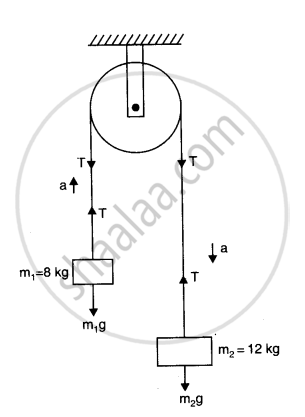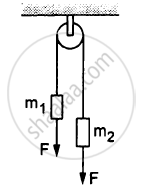Advertisements
Advertisements
Question
Two masses 8 kg and 12 kg are connected at the two ends of a light, inextensible string that goes over a frictionless pulley. Find the acceleration of the masses, and the tension in the string when the masses are released.
Solution
The given system of two masses and a pulley can be represented as shown in the following figure:

Smaller mass, m1 = 8 kg
Larger mass, m2 = 12 kg
Tension in the string = T
Mass m2, owing to its weight, moves downward with acceleration a,and mass m1moves upward.
Applying Newton’s second law of motion to the system of each mass:
For mass m1:
The equation of motion can be written as:
T – m1g = ma … (i)
For mass m2:
The equation of motion can be written as:
m2g – T = m2a … (ii)
Adding equations (i) and (ii), we get:
(m_2-m_1)g = (m_1+ m_2)a
`:.a = ((m_2-m_1)/(m_1+m_2))g ...(iii)`
`=((12-8)/(12+8)) xx 10= 4/20 xx 10 = 2 "m/s"^2`
Therefore, the acceleration of the masses is 2 m/s2.
Substituting the value of a in equation (ii), we get:
`m_2g - T = m_2 ( (m_2-m_1)/(m_1+m_2))g`
`=((2m_1m_2)/(m_1+m_2))g`
`=(2xx12xx8)/(12+8)xx10`
`=(2xx12xx8)/20 xx 10 = 96 N`
Therefore, the tension in the string is 96 N.
APPEARS IN
RELATED QUESTIONS
Two bodies of masses 10 kg and 20 kg respectively kept on a smooth, horizontal surface are tied to the ends of a light string. A horizontal force F = 600 N is applied to
- A,
- B along the direction of string. What is the tension in the string in each case?
Two blocks of equal mass m are tied to each other through a light string. One of the blocks is pulled along the line joining them with a constant force F. Find the tension in the string joining the blocks.
Consider the Atwood machine of the previous problem. The larger mass is stopped for a moment, 2.0 s after the system is set into motion. Find the time that elapses before the string is tight again.
In the following figure, m1 = 5 kg, m2 = 2 kg and F = 1 N. Find the acceleration of either block. Describe the motion of m1 if the string breaks but F continues to act.

In the previous problem, suppose m2 = 2.0 kg and m3 = 3.0 kg. What should be the mass m, so that it remains at rest?
State the Newton's second law of motion. What information do you get from it?
The linear momentum of a ball of mass 50 g is 0.5 kg m s-1. Find its velocity.
What do you understand by the term momentum?
What do you mean by linear momentum of a body?
State Newton's second law of motion.
A body of mass 400 g is resting on a frictionless table. Find the acceleration of the body when acted upon by a force of 0.02 N.
